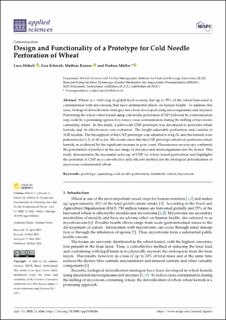Bitte benutzen Sie diese Kennung, um auf die Ressource zu verweisen:
https://doi.org/10.21256/zhaw-28026| Publikationstyp: | Beitrag in wissenschaftlicher Zeitschrift |
| Art der Begutachtung: | Peer review (Publikation) |
| Titel: | Design and functionality of a prototype for cold needle perforation of wheat |
| Autor/-in: | Stäheli, Luca Schwab, Lisa Kinner, Mathias Müller, Nadina |
| et. al: | No |
| DOI: | 10.3390/app13106266 10.21256/zhaw-28026 |
| Erschienen in: | Applied Sciences |
| Band(Heft): | 13 |
| Heft: | 10 |
| Seite(n): | 6266 |
| Erscheinungsdatum: | 20-Mai-2023 |
| Verlag / Hrsg. Institution: | MDPI |
| ISSN: | 2076-3417 |
| Sprache: | Englisch |
| Schlagwörter: | Prototype; Upscaling; Cold needle perforation; Treatment; Wheat; Mycotoxin |
| Fachgebiet (DDC): | 664: Lebensmitteltechnologie |
| Zusammenfassung: | Wheat is a vital crop in global food security, but up to 25% of the wheat harvested is contaminated with mycotoxins that have detrimental effects on human health. To address this issue, biological detoxification strategies have been developed using microorganisms and enzymes. Perforating the whole wheat kernel using cold needle perforation (CNP) followed by a detoxification step could be a promising approach to reduce cross-contamination during the milling of mycotoxin-containing wheat. In this study, a pilot-scale CNP prototype was developed to perforate wheat kernels, and its effectiveness was evaluated. The height-adjustable perforation unit consists of 3120 needles. The throughput of the CNP prototype was adjusted to 6 kg/h, and the kernels were perforated for 1, 5, or 10 cycles. The results show that the CNP prototype effectively perforates wheat kernels, as evidenced by the significant increase in pore count. Fluorescence microscopy confirmed the penetration of particles in the size range of enzymes and microorganisms into the kernel. This study demonstrates the successful scale-up of CNP for wheat kernel perforation and highlights the potential of CNP as a cost-effective and efficient method for the biological detoxification of mycotoxin-contaminated wheat. |
| URI: | https://digitalcollection.zhaw.ch/handle/11475/28026 |
| Volltext Version: | Publizierte Version |
| Lizenz (gemäss Verlagsvertrag): | CC BY 4.0: Namensnennung 4.0 International |
| Departement: | Life Sciences und Facility Management |
| Organisationseinheit: | Institut für Lebensmittel- und Getränkeinnovation (ILGI) |
| Publiziert im Rahmen des ZHAW-Projekts: | Strategien zur Reduktion von Mykotoxinen in Getreidenebenproduktströmen |
| Enthalten in den Sammlungen: | Publikationen Life Sciences und Facility Management |
Dateien zu dieser Ressource:
| Datei | Beschreibung | Größe | Format | |
|---|---|---|---|---|
| 2023_Staeheli-etal_Prototype-for-cold-needle-perforation-of-wheat.pdf | 2.66 MB | Adobe PDF |  Öffnen/Anzeigen |
Zur Langanzeige
Stäheli, L., Schwab, L., Kinner, M., & Müller, N. (2023). Design and functionality of a prototype for cold needle perforation of wheat. Applied Sciences, 13(10), 6266. https://doi.org/10.3390/app13106266
Stäheli, L. et al. (2023) ‘Design and functionality of a prototype for cold needle perforation of wheat’, Applied Sciences, 13(10), p. 6266. Available at: https://doi.org/10.3390/app13106266.
L. Stäheli, L. Schwab, M. Kinner, and N. Müller, “Design and functionality of a prototype for cold needle perforation of wheat,” Applied Sciences, vol. 13, no. 10, p. 6266, May 2023, doi: 10.3390/app13106266.
STÄHELI, Luca, Lisa SCHWAB, Mathias KINNER und Nadina MÜLLER, 2023. Design and functionality of a prototype for cold needle perforation of wheat. Applied Sciences. 20 Mai 2023. Bd. 13, Nr. 10, S. 6266. DOI 10.3390/app13106266
Stäheli, Luca, Lisa Schwab, Mathias Kinner, and Nadina Müller. 2023. “Design and Functionality of a Prototype for Cold Needle Perforation of Wheat.” Applied Sciences 13 (10): 6266. https://doi.org/10.3390/app13106266.
Stäheli, Luca, et al. “Design and Functionality of a Prototype for Cold Needle Perforation of Wheat.” Applied Sciences, vol. 13, no. 10, May 2023, p. 6266, https://doi.org/10.3390/app13106266.
Alle Ressourcen in diesem Repository sind urheberrechtlich geschützt, soweit nicht anderweitig angezeigt.